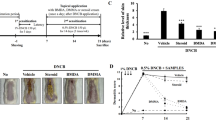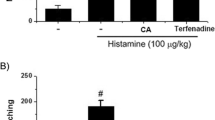Abstract
In this study, we topically administered two antioxidant compounds, the manganese-porphyrin-derivatives BMX-001 and BMX-010, in a mouse model of allergic dermatitis and compared the efficacy for reduction of itch and inflammation. In vitro effects of BMX-001 and BMX-010 on keratinocytes, bone marrow derived dendritic cells (BMDCs) and T-cells were initially analysed. For assessment of scratching behaviour, BMX-001 and BMX-010 (0.01 and 0.1 %) were topically applied 16 h and/or 1 h before compound 48/80 or toluene-2,4,-diisocyanate (TDI) challenge in a TDI induced mouse dermatitis model. Additionally, assessment of allergic skin inflammation was performed in a similar manner in the TDI model. Post-treatment ear thickness was measured 24 h after TDI challenge and compared to basal values. The mice were sacrificed and the ear auricle was removed for further analysis. In vitro, both BMX substances significantly inhibited cytokine production of keratinocytes as well as of BMDC and T-cell proliferation. Topical treatment with BMX cream resulted in a significant decrease in scratching behaviour in the compound 48/80 model, but not in the TDI model. Mice treated with BMX-001 and BMX-010 showed a moderate dose dependent decrease in ear thickness, and interestingly, the concentration of the cytokines IL-1β and IL-4 in inflamed skin was reduced by 80–90 % by all treatment options. These first results suggest the potential benefit of a BMX-001 and BMX-010 cream for the treatment of allergic-inflammatory skin diseases.






Similar content being viewed by others
References
Aikawa T, Ito S, Shinohara M, Kaneko M, Kondo T, Yuasa M (2015) A drug formulation using an alginate hydrogel matrix for efficient oral delivery of the manganese porphyrin-based superoxide dismutase mimic. Biomater Sci 3(6):861–869
Akiyama T, Carstens E (2013) Neural processing of itch. Neuroscience 250:697–714
Archambeau JO, Tovmasyan A, Pearlstein RD, Crapo JD, Batinic-Haberle I (2013) Superoxide dismutase mimic, MnTE-2-PyP(5+) ameliorates acute and chronic proctitis following focal proton irradiation of the rat rectum. Redox Biol 1:599–607
Batinic-Haberle I, Rajic Z, Tovmasyan A, Reboucas JS, Ye X, Leong KW, Dewhirst MW, Vujaskovic Z, Benov L, Spasojevic I (2011) Diverse functions of cationic Mn(III) N-substituted pyridylporphyrins, recognized as SOD mimics. Free Radic Biol Med 51(5):1035–1053
Batinic-Haberle I, Reboucas JS, Spasojevic I (2010) Superoxide dismutase mimics: chemistry, pharmacology, and therapeutic potential. Antioxid Redox Signal 13(6):877–918
Batinic-Haberle I, Tovmasyan A, Roberts ER, Vujaskovic Z, Leong KW, Spasojevic I (2014) SOD therapeutics: latest insights into their structure-activity relationships and impact on the cellular redox-based signaling pathways. Antioxid Redox Signal 20(15):2372–2415
Baumer W, Kietzmann M (2007) Effects of cyclosporin A and cilomilast on activated canine, murine and human keratinocytes. Vet Dermatol 18(2):107–114
Baumer W, Seegers U, Braun M, Tschernig T, Kietzmann M (2004) TARC and RANTES, but not CTACK, are induced in two models of allergic contact dermatitis. Effects of cilomilast and diflorasone diacetate on T-cell-attracting chemokines. Br J Dermatol 151(4):823–830
Baumer W, Tschernig T, Sulzle B, Seegers U, Luhrmann A, Kietzmann M (2003) Effects of cilomilast on dendritic cell function in contact sensitivity and dendritic cell migration through skin. Eur J Pharmacol 481(2–3):271–279
Baumer W, Wlaz P, Jennings G, Rundfeldt C (2010) The putative lipid raft modulator miltefosine displays immunomodulatory action in T-cell dependent dermal inflammation models. Eur J Pharmacol 628(1–3):226–232
Fukuyama T, Ehling S, Cook E, Baumer W (2015) Topically administered Janus-Kinase inhibitors tofacitinib and oclacitinib display impressive antipruritic and anti-inflammatory responses in a model of allergic dermatitis. J Pharmacol Exp Ther 354(3):394–405
Liu T, Ji RR (2013) New insights into the mechanisms of itch: are pain and itch controlled by distinct mechanisms? Pflugers Arch 465(12):1671–1685
Lutz MB, Kukutsch N, Ogilvie AL, Rossner S, Koch F, Romani N, Schuler G (1999) An advanced culture method for generating large quantities of highly pure dendritic cells from mouse bone marrow. J Immunol Methods 223(1):77–92
Orrenius S, Gogvadze V, Zhivotovsky B (2007) Mitochondrial oxidative stress: implications for cell death. Annu Rev Pharmacol Toxicol 47:143–183
Ring J, Alomar A, Bieber T, Deleuran M, Fink-Wagner A, Gelmetti C, Gieler U, Lipozencic J, Luger T, Oranje AP, Schafer T, Schwennesen T, Seidenari S, Simon D, Stander S, Stingl G, Szalai S, Szepietowski JC, Taieb A, Werfel T, Wollenberg A, Darsow U (2012) Guidelines for treatment of atopic eczema (atopic dermatitis) Part II. J Eur Acad Dermatol Venereol 26(9):1176–1193
Ring J, Alomar A, Bieber T, Deleuran M, Fink-Wagner A, Gelmetti C, Gieler U, Lipozencic J, Luger T, Oranje AP, Schafer T, Schwennesen T, Seidenari S, Simon D, Stander S, Stingl G, Szalai S, Szepietowski JC, Taieb A, Werfel T, Wollenberg A, Darsow U (2012) Guidelines for treatment of atopic eczema (atopic dermatitis) part I. J Eur Acad Dermatol Venereol 26(8):1045–1060
Shim M, Powers KL, Ewing SJ, Zhu S, Smart RC (2005) Diminished expression of C/EBPalpha in skin carcinomas is linked to oncogenic Ras and reexpression of C/EBPalpha in carcinoma cells inhibits proliferation. Cancer Res 65(3):861–867
Steinhoff M, Brzoska T, Luger TA (2001) Keratinocytes in epidermal immune responses. Curr Opin Allergy Clin Immunol 1(5):469–476
Steinman RM (2007) Lasker Basic Medical Research Award. Dendritic cells: versatile controllers of the immune system. Nat Med 13(10):1155–1159
van de Wetering CI, Coleman MC, Spitz DR, Smith BJ, Knudson CM (2008) Manganese superoxide dismutase gene dosage affects chromosomal instability and tumor onset in a mouse model of T cell lymphoma. Free Radic Biol Med 44(8):1677–1686
Wang YH, Xu XJ, Li HL (2014) Hepatoprotective effects of mimic of manganese superoxide dismutase against carbon tetrachloride-induced hepatic injury. Int Immunopharmacol 22(1):126–132
Werfel T (2009) The role of leukocytes, keratinocytes, and allergen-specific IgE in the development of atopic dermatitis. J Invest Dermatol 129(8):1878–1891
Wilson SR, The L, Batia LM, Beattie K, Katibah GE, McClain SP, Pellegrino M, Estandian DM, Bautista DM (2013) The epithelial cell-derived atopic dermatitis cytokine TSLP activates neurons to induce itch. Cell 155(2):285–295
Acknowledgments
This work was funded by BioMimetix JV, LLC. We deeply appreciate Dr. Sarah Ehling and Dr. Joy Rachel Ganchingco (North Carolina State College of Veterinary Medicine) for their variable suggestions and discussions.
Author information
Authors and Affiliations
Corresponding author
Ethics declarations
Conflict of interest
Authors K.S., T.F., M.A.D., K,T,Y., and W.B. have no conflicts of interest. J.D.C. is manager of BioMimetix JV, LLC, and holds equity. R.E.O.D. has equity in BioMimetix JV, LLC.
Additional information
K. Stover and T. Fukuyama shared first authorship.
Rights and permissions
About this article
Cite this article
Stover, K., Fukuyama, T., Young, A.T. et al. Topically applied manganese-porphyrins BMX-001 and BMX-010 display a significant anti-inflammatory response in a mouse model of allergic dermatitis. Arch Dermatol Res 308, 711–721 (2016). https://doi.org/10.1007/s00403-016-1693-0
Received:
Revised:
Accepted:
Published:
Issue Date:
DOI: https://doi.org/10.1007/s00403-016-1693-0




